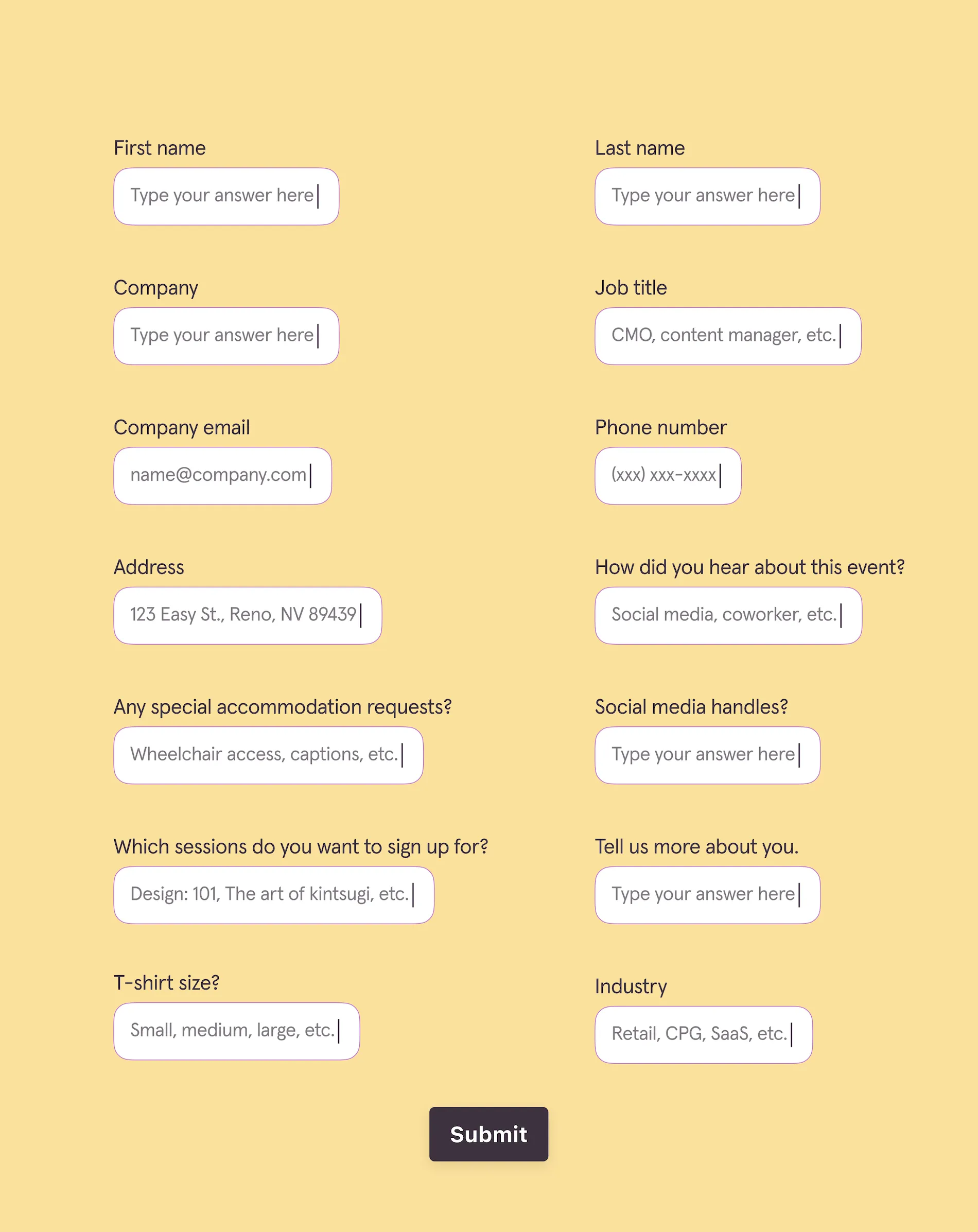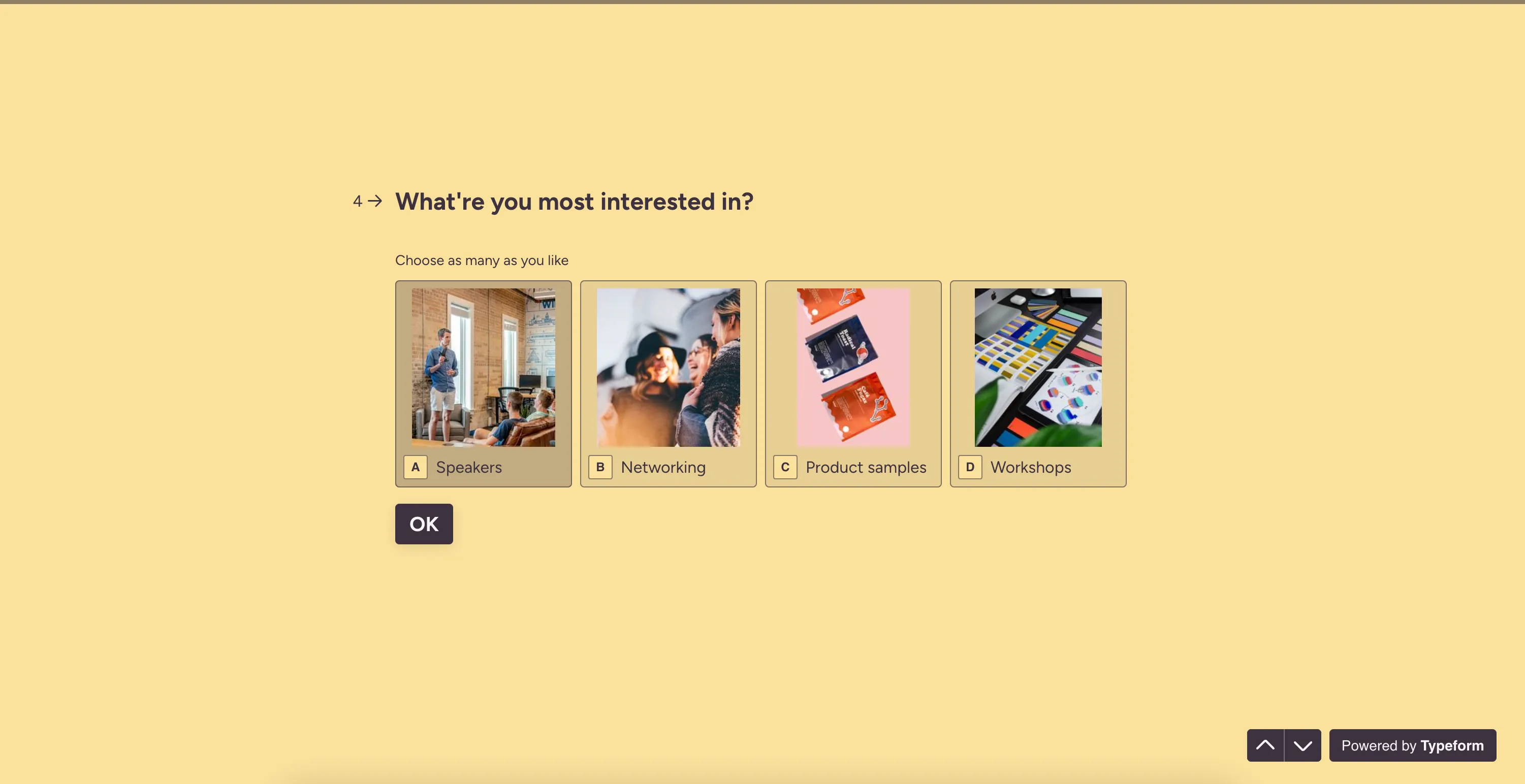Why the event registration experience is more than just a process
Creating an exceptional event experience starts long before the event—you make your first impression during registration. See why registration is more than just a process and how to give registrants a great experience before the event even begins.

Contents
You've built an entire campaign around your upcoming event—from promotional emails to website banners, to social media hype posts.
You've hand-picked top experts in their fields to run workshops and speak at your virtual summit.
You’ve even created your post-event feedback survey to collect invaluable insights once the event ends.
But what about your event registration experience? Have you even considered it? Despite registration being one of the first touchpoints potential attendees have with your event, you're still treating it as a process, a transaction.
Your process looks a little something like this:
✅ Visit registration page
✅ Input personal and company details
✅ Register
✅ Get a confirmation email
Not very inspiring (or human).
You've put so much care into every little detail surrounding your event to create a stellar attendee experience. Your event registration strategy deserves the same level of care.
Why? Because the reality is that the event registration experience shapes whether a visitor actually registers, if they'll attend the event after registering, and how engaged they'll be.

After all, a poor event registration experience sets a low bar for the event and doesn't encourage engagement.
Long story short? Registration matters—take it seriously and treat it as an experience, not a transactional part of the sign-up process.
Find out why traditional event registration is on its way out, why brands treating the registration process as an experience are winning, and how you can design an event registration experience that boosts attendance.
Say goodbye to traditional, transactional event registration
Even if you're hosting a free event, you're still likely trying to generate leads to bring in revenue in the long run. And if you're charging a ticket fee, you're definitely trying to generate money.
But that doesn't mean you have to treat registrants as transactions.
No one wants to feel like a dollar sign or a nameless face. Yet traditional registration processes do precisely that. Instead of creating an interactive event registration experience, the sign-up process of yesteryear is:
- Long and inconsiderate. These sign-up forms ask any and every question imaginable, not considering that visitors may not want to spend 15 minutes just to register for an event.
- Impersonal and cold. Registration forms don't use any level of personalization, adding to that "transactional" feel instead of creating an inviting event registration experience.
- Clunky. You've got a problem when your registration form feels like a chore. Visitors shouldn't have to answer irrelevant questions or have to figure out how to navigate a clunky user interface.
Pitfalls to look out for with typical event sign-up forms
We've all experienced never-ending forms with no branding, no personality, that feel more like a pain and less like signing up for an exciting event.
Not ideal when you're trying to get people to register. Take a look at the mock event registration form below. Notice anything that looks unenticing?
- Countless form fields encourage form-takers to give up before completing registration.
- It's generic—there's no branding, and it's not interactive. It just feels standard and uninspired.
- There's no personalization, so it feels more like a task for registrants than an event registration experience.
- It’s not mobile-friendly, so anyone trying to register on their phone will likely bounce before they even begin.

Would you fill out that form? I wouldn't. There's no branding, no intro to the event, just a bunch of questions. And it's not optimized for mobile.
Here's why that matters:
- Personify's 20203 A2Z Guide to Event Registration: Navigating Event Registration Challenges and Opportunities survey found that 55% of event organizers anticipate a shift toward mobile registration.
- Personify's survey also revealed that 54% of respondents stated "ease of use" as the most important factor in the registration process.
And guess what? Forms like this have lower sign-up conversion rates and higher no-show rates.
4 elements of an event registration experience
Not sure how to improve event sign-ups? Stop thinking about registration as just a form—it's an opportunity to create an event experience that builds anticipation and jumpstarts a successful event before the actual day of the event.
We're breaking down four crucial elements to creating a pleasant event registration experience.
1. Capture the visitor’s attention

While a beautifully branded event sign-up form will certainly grab attention, think more holistically about attracting the right people to your event. Grab—and keep—visitors' attention by:
- Promoting workshops or speakers your target audience will love
- Using cross-promotion with emails, social media, or other channels your audience uses to make them aware of your event
- Leveraging an inviting and conversational sign-up form to create a memorable event registration experience
- Using messaging that builds anticipation and gets visitors ready to sign up
Understand your ideal customer profile and what will make them tap "Register," then build a highly personalized strategy around them.
2. Make it frictionless

We want things to be convenient and effortless—including sign-up forms. Make your event registration experience as frictionless as possible by allowing visitors to register with the least amount of work, like:
- Having minimal form fields and not requiring an answer for every field
- Allowing visitors to move through the sign-up form quickly
- Using progressive profiling to collect data little by little vs. all at once
- Optimizing your event registration form for mobile so visitors can fill it out however's most convenient for them
- Showing a progress bar or a time to complete estimate so visitors know how much more they have to fill out
It's all about making signing up for your event easy. Event registration should get visitors excited about your event, not dreading answering dozens of questions.
3. Personalize the experience

Personalization extends far beyond emails—it's about personalizing every element of the attendee journey. And since the event registration experience is one of their first interactions with your event, personalization should start there.
Yes, you want to use the registrant's name throughout the sign-up form, but there are several other ways you can personalize, like using recall and logic.
Recall allows you to pull information from previous answers and fully tailor your next questions. Let's say they indicate that they're a B2B marketer. You can recall that information in later questions, referencing how the questions connect to B2B marketers.
Logic is another powerful way to personalize the event registration experience. By routing visitors to only relevant questions based on their answers, you create a personalized series of questions vs. having visitors answer every question.
4. Build anticipation around the event

Instead of a simple, "Thanks for registering," leave registrants wanting more. An end screen with a quick message about behind-the-scenes content, tips to come, or other enticing content can get visitors excited about the event and keep them engaged pre-event.
But beyond the event sign-up form, you can build anticipation in the inbox and on social media by hyping up speakers, sharing exclusive tips, and offering sneak peeks into event workshops and more.
Create a better event registration experience
The best event registration forms are seamless, engaging, and interactive.
They pull visitors in and encourage them to sign up. How?
- Sign-up forms use warm and inviting branding and clear messaging to highlight the event's value prop.
- Interactive event registration forms change up question types to keep visitors engaged while filling out the form.
- Event registration forms connect seamlessly to email to auto-send confirmation emails and CRMs to make data collection and segmentation effortless.
The science behind an effective event registration experience
Want to transform your sign-up process into an event registration experience? Take a scientific approach. Understanding the psychology behind why people sign up for your event—or don't—can help you optimize registration to bring in more sign-ups (and attendees).
Registration isn’t a judgment-free zone
Who would've thought that a simple sign-up form could make or break your event attendance goals? Well, the event registration form is where you make your first impression—it's where people judge your entire event.
Sure, it's just one part of the attendee journey. But if your sign-up form is boring, overwhelming, or discourages completions, visitors will bounce before hitting, "Register."
Think of the sign-up process as... you guessed it—an experience. Put the same amount of care into it as the actual event to create an unforgettable first impression that drives registrations.
Commitment boosts attendance
If you've ever booked a hair appointment or facial at a swanky spa, you've probably had to put your credit card on file so they can charge you should you cancel. It's a negative consequence of not keeping your commitment.
But commitment can be driven by more positive factors, like personalization and engagement. Commitment psychology tells us that (typically) once we make a decision, we align our behavior to that decision.
So, let's say someone signs up for your event. Commitment psychology would say they're more likely to attend because they signed up. But to get them to attend, you need them to sign up first.
And the more personal you make the registration process, the higher the likelihood they'll attend the event. Why? Because you're building a personal connection with each visitor that drives their commitment to sign up and attend.
Less work means more sign-ups
We've already discussed how overwhelming 20+ form fields can be to a form-taker. But you can also turn off visitors by overcomplicating your registration process.
Are you using overly academic language? Asking too many questions? Requiring too many steps?
Cognitive load—the mental effort needed to process information and how much information our working memory can process at once—dictates that requiring too much from registrants will likely decrease registrations.
Why?
Because our brains want to reduce cognitive load whenever possible. We want things to be simple (and not overwhelming). So, instead of multiple steps, countless questions, and language that requires a dictionary, do this instead:
- Keep it simple
- Keep it short
- Use plain language
- Reduce cognitive load as much as possible
By lowering the cognitive load, you can drive higher completion rates from visitors who can make it through your form without much effort.
Event registration best practices to boost attendance

You've got the event registration strategy down and know how to leverage psychological triggers. Now what? It's time to create an engaging, interactive event registration form.
Here's everything you need to know to design a form that converts:
- Be conversational. Overly formal or academic language can feel cold and uninviting. Use a friendly tone to build rapport and invite visitors in. Asking one question at a time, calling them by name, and using casual language increases trust and the likelihood your visitor will complete the event registration.
- Be relevant. No one likes answering irrelevant questions—so don't ask them. Using conditional logic lets you route form-takers to the right next question based on previous answers. Think of it as, "If this, then that." If they say they're interested in workshops only, you can direct them to questions only about workshops.
- Be connected. You're probably hosting an event to generate leads. So why would you not connect your event registration form to your CRM? Use integrations to connect your sign-up form to tools like a CRM or email marketing provider to flow data between tools and enable hyper-personalization.
- Be future-minded. The goal of your event registration form is to collect data, generate leads, and drive attendance. But it's also a powerful tool for collecting zero-party data (ZPD) and post-event feedback to use in post-event nurturing. ZPD is the ultimate data for personalization—gather as much as you can in the sign-up form.
Create experience-driven event sign-up forms to drive registrations

Generic, process-driven event registrations are out. Event registration experiences are in. That means:
- Personalization
- Branded forms
- Only asking relevant questions
- Being conversational
It's about creating an experience instead of treating it as a to-do list task. Yes, your event registration form should collect data. But it should also be an interactive event registration form that engages visitors, gets them excited, and converts them into attendees.
The brands treating event registration as an experience—the ones prioritizing the visitor's interaction with them—they're the ones with sky-high attendance rates. The ones with high satisfaction scores. The ones who get rewarded for putting their registrants first.
If you don't want to get left behind, it's time to start rethinking the sign-up process as an event registration experience.
With a conversational flow, eye-catching designs, and a truly registrant-first experience, Typeform makes the sign-up process less of a process and more of an exciting experience for visitors. Try it out—for free.
Liked that? Check these out:
.webp)
Tips
12 customer satisfaction questions that reveal real insights
Customer satisfaction surveys getting vague answers (or no answers at all)? The problem isn't your customers, it's your questions. Use these 12 CSAT questions to ask the right questions at the right time to boost response rates—and help you improve your customer experience.
Más información

Tips
14 examples of ranking survey questions to use in 2026
Get to know your customers and use their survey responses to make data-driven decisions with ranking survey questions that help you uncover more. We’ve rounded up 14 real-world examples to inspire your next survey and make creating effective ranking questions effortless.
Más información

